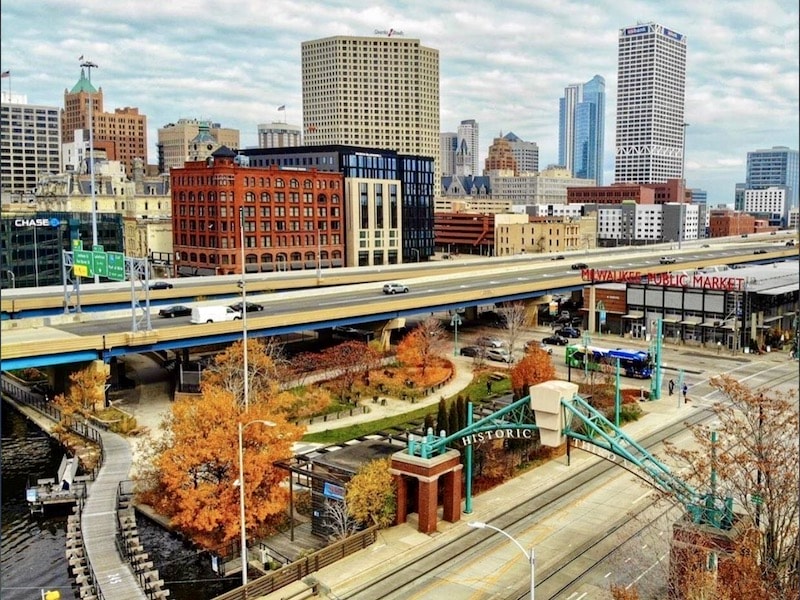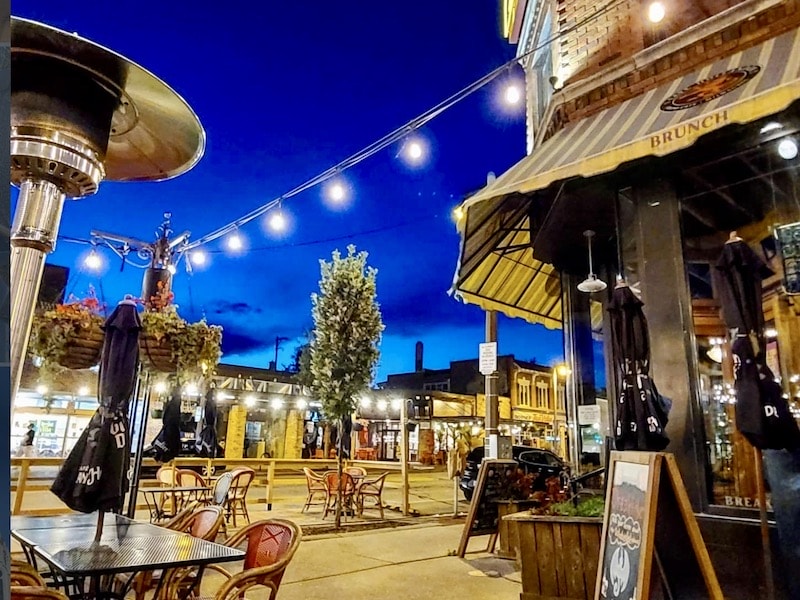Mending Our Broken Heart: Milwaukee Reclaims its Land–and River

Published October 17th, 2022 at 11:30 AM
“Downtown KC: Mending Our Broken Heart,” was a groundbreaking series originally published by The Kansas City Star 20 years ago this month.
It was written by former staffers Jeffrey Spivak, Kevin Collison and Steve Paul, with photographs by Rich Suggs. It was edited by former deputy national editor Keith Chrostowski.
CityScene KC thanks The Kansas City Star and Mike Fannin, its president and editor, for granting permission to republish this report.
While The Star retained the text of “Mending Our Broken Heart,” the original photos and graphics were unavailable. Photos of that missing material from a reprint of the series were used as much as possible.
MILWAUKEE–If local officials were really smart, they’d keep one of the big bones of the freeway they’re dismantling here and call it public art.
A tall concrete column with a coif of scrambled rebar would be a permanent reminder of how highways disrupted downtown.
But maybe it’s impressive enough that Milwaukee is reclaiming about 26 acres of prime downtown land for new uses.
That’s just one multimillion-dollar sign that Milwaukee is serious about creating a new sense of its downtown. Along with a photogenic addition to its art museum and dressed-up accessible riverfront, Milwaukee is presenting itself as a can-do place, proud of what it is and has.
“I was blown away by how much progress they’ve made,” says Mike Bosc, who returned recently to Milwaukee for the first time in 16 years. “The whole city was spit-shined.”
Bosc traveled here last month with a delegation of 125 civic leaders from Louisville who chose Milwaukee for their annual look-and-see trek.
“It says community pride,” says Bosc, vice president of Greater Louisville, Inc.–The Metro Chamber of Commerce. “It says that the city of Milwaukee cares about what the rest of the world thinks about it.”
Early last year The Utne Reader, an alternative bimonthly, ranked Milwaukee No. 1 on its list of underrated towns, a hint that others are beginning to notice what’s going on.
Pat Algiers, a corporate designer at the Kahler Slater architectural firm, spent much of the last year analyzing socioeconomic data of Milwaukee’s downtown. That helped make more people aware of the opportunities prompted by a recent housing boom.
“This magnificent neighborhood, really an ecosystem, has emerged and is still emerging under the radar in Milwaukee,” Algiers says.
Algiers inventoried downtown’s businesses, housing and entertainment clusters to creat a series of maps and a “Live Work Play Index.”

An outdoor cafe in downtown Milwaukee (Photo from Visit Milwaukee website)
She and her colleagues have been meeting with civic leaders to get across a message that exciting things were happening in their town–and that more was possible by focusing on “ignitor” projects that can generate further economic activity.
Algiers also counted 215 small tech companies plus 150 or more “creative” businesses operating downtown–a resident core of youthful energy and spending patterns.
By demolishing a one-mile highway spur called the Park East Freeway. Milwaukee is reconnecting neighborhoods and former industrial areas with the central part of downtown.
“It’s such a waste to have a freeway using this kind of land,” says Mike Wisniewski of the city’s development department.
Developers have been lining up to take advantage: A Cleveland company acquired a vacant Pabst brewery to create an entertainment complex and Harley-Davidson plans to build a museum on land made more desirable by the freeway demolition project is expected to spur more than $250 million in commercial development on the reclaimed land alone.
The freeway demolition is closely linked to what’s been happening along the Milwaukee River, a narrow waterway that runs through the center of downtown.
Buildings that once had their backs along the river now sport terraces for cafes and beer halls. Pontoons, sculls and canoes ply the water for fun and competition.
A RiverWalk, mostly completed in the central downtown district, is being extended north and south and eventually will connect with Lake Michigan walkways.
The river cleanup and riverfront revival became a top priority in Mayor John Q. Norquist’s first term beginning in 1988. It took more than four years of negotiations with the state Department of Natural Resources to negotiate what could and couldn’t be done, Wisniewski said. And once that was determine, the city developed its plan.
“The mayor understood immediately the importance of doing the river,” Wisniewski says. “The mayor turns to the budget director and says: “Find me this money. And make sure it’s new money.’
“When you have the full force of the city’s leadership behind you, you can get things done.”
According to the city figures, central downtown property values have increase 54 percent, or $184 million, since 1994, growth attributed to the $16 million first-phase construction of the RiverWalk.
Norquist is a widely known advocate of what’s called the new urbanism. He’s even written a book on the subject: The Wealth of Cities: Revitalizing the Centers of American Life. In his office one afternoon, he talks about how Milwaukee avoids subsidizing development so that housing reflects real market prices–as well as the interests of urban dwellers.
“The idea you need to bribe people to live downtown is self-defeating,” Norquist says. “Urbanism is what people will pay for downtown. They won’t pay for suburbanism downtown.”
Norquist’s emphasis on urbanism also means a focus on the things that create a strong sense of place: pedestrian activity, mixed-use development, and respect for good architecture–“the beauty,” he says, “of what happens when buildings are built in relation to one another.”
City officials have streamlined many development processes and made it easier to create street-level activity.
Sidewalk cafes, for instance, used to be nearly impossible to get approved.
A couple years ago, planning director Peter Park did something about it. “I just wrote a few guidelines,” he said. “It’s certainly what makes Paris and interesting city.”
the result: Restaurants all around downtown’s dining districts set up tables and chairs outside their front windows–at least in the summer.
“This year was the first time we did it, and we were packed every night,” says Bryce Clark, co-owner of Cempazuchi, a Oaxacan restaurant on trendy Brady Street. “It’s what you do if you want to be the kind of city where people are outside and want to see and be seen.”
The small grill was sizzling, and lunch business was brisk one day at Richard Niemczynski’s downtown sausage wagon.
Four years ago, Niemczynski returned to his native Milwaukee from a few years testing the waters in Florida. Now, he says, he does more business in seven months in Milwaukee than he was doing in 12 in Florida.
He’s got a prominent spot in a public plaza a block off the RiverWalk.
He serves mainly Usinger’s sausages–bratwursts, Hungarian and other varieties. These are “serious,” locally made sausages, he says. A bit more expensive, but worth it. Much better, he says, than his competitors’ Chicago-made franks.
“C’mon,” he says. “This is Milwaukee.”


